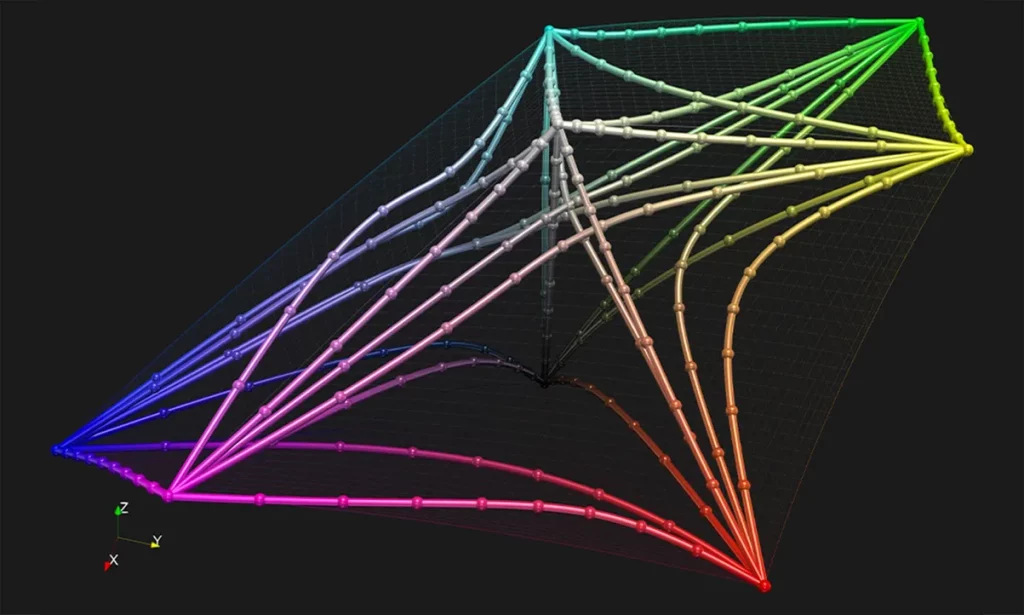A paradigm shift away from the 3D mathematical description developed by Schrödinger and others to describe how we see color can lead to more vibrant computer screens, televisions, textiles, printed materials, and more.
New research corrects a major flaw in 3D mathematical space developed by Nobel Prize-winning physicist Erwin Schrödinger and others to describe how your eyes distinguish one color from another. This incorrect model has been used by scientists and industry for over 100 years. The study has the potential to improve scientific data visualizations, improve television sets and recalibrate the textile and dyeing industry.
“The supposed shape of color space requires a paradigm shift,” said Roxana Bojak, a computer scientist with a background in mathematics who has presented science visualizations at Los Alamos National Laboratory. Bujack is the lead author of a Los Alamos team paper on the mathematics of color perception. Published in Proceedings of the National Academy of Sciences.
“Our research shows that the current mathematical model of how the eye perceives color differences is incorrect. This model was proposed by Bernhard Riemann and developed by Hermann von Helmholtz and Erwin Schrödinger – all giants in mathematics and physics – and proving an error is largely a scientist’s dream.”
Human color perception modeling enables the automation of image processing, computer graphics, and visualization tasks.
The Los Alamos team is correcting mathematicians, including Nobel Prize-winning physicist Erwin Schrödinger, who used to describe how your eye distinguishes one color from another.
“Our original idea was to develop algorithms to automatically improve color maps to visualize data so that it is easier to understand and interpret,” Bojak says. So the research team was surprised to find that they were the first to discover that the long-term application of Riemann’s geometry, which allows to generalize straight lines to curved surfaces, did not work.
An accurate mathematical model of the perceived color space is needed to set industry standards. Early attempts made use of Euclidean spaces – the familiar geometry taught in many high schools. Later, more advanced models used Riemann geometry. Red, green, and blue models in 3D space. These are the colors that are powerfully captured by the light-detecting cones on the retina and, not surprisingly, the colors that blend together to create all the images on an RGB computer screen.
In the study, which combines psychology, biology, and mathematics, Bojak and her colleagues found that using Riemann geometry exaggerates the perception of large differences in color. This is because people understand that a large difference in color is less than the total that you will get when you add small color differences between two widely separated colors.
Riemannian geometry cannot explain this effect.
“We weren’t expecting this and don’t yet know the exact geometry of this new color space,” Bujack said. “We might think of it as normal, but with the addition of hydration or a weight function that travels long distances, making it shorter. But we can’t prove that yet.”
Reference: “The Non-Riemannian Nature of Perceptual Color Space” By Roxana Bojak, Emily Tate, Jonah Miller, Electra Caffrey, and Teresh L. Turton, Apr 29, 2022 Available here Proceedings of the National Academy of Sciences.
DOI: 10.1073/pnas.2119753119
Funding: Los Alamos National Laboratory Laboratory-Based Research and Development Program.

“Thinker. Coffeeaholic. Award-winning gamer. Web trailblazer. Pop culture scholar. Beer guru. Food specialist.”

:format(jpeg):fill(f8f8f8,true)/s3/static.nrc.nl/bvhw/wp-content/blogs.dir/114/files/2021/11/trujilo-vierkant.png)





More Stories
iPhone SE 4: Bigger screen and Face ID feature according to new rumors
Grass snake and lizard are rare – Zeeuwsch Vlaanderen Advertisement | Zeeuwsch Flemish Advertising Magazine
Belgian co-production with acclaimed actor Crispin Glover selected for Toronto Film Festival